The events that unfolded last year brought safety to the forefront of everyone’s minds. Personal protective equipment (PPE) became a term even those who had never used it before were familiar with as we all navigated a new world where staying safe was of the utmost importance. This renewed focus on safety can help make a difference in reducing electrically related deaths, injuries, and property losses. All workers must understand that every work environment presents different electrical hazards and learn how to prevent them. The data below seeks to accomplish both goals.
The Electrical Safety Foundation International (ESFI), using the U.S. Bureau of Labor Statistics’ (BLS) Census of Fatal Occupational Injuries (CFOI) and Survey of Occupational Injuries (SOII), provides yearly statistical data on fatal and nonfatal occupational electrical injuries on esfi.org. This information helps us better understand the incidents occurring to educate employers and workers alike to prevent future accidents. This latest data published by the BLS covers incidents from 1992 to 2019 but focuses heavily on 2011 to 2019 data.
Fatal Electrical Injuries
In 2019, there were 166 electrical fatalities, which was a 3.75% increase over 2018 and the highest number of electrical fatalities since 2011. Contact with or exposure to electric current accounted for 3% of all fatalities, maintaining the same percentage as in 2018. Electrical fatality rates were 0.11 fatalities per 100,000 workers, while the rate for all fatalities was 3.6 per 100,000 workers. In 2019, 8% of all electrical injuries were fatal. The construction industry had the highest rate of fatal electrical injuries, 0.7 fatalities per 100,000 workers, followed by the utility industry, 0.4 fatalities per 100,000 workers. All industries had 0.1 fatalities per 100,000 workers. The number of electrical fatalities varied between age groups. Eleven percent occurred in workers aged 20 to 24, 30% occurred in workers aged 25 to 34, 27% occurred in workers aged 34 to 44, 17% occurred in workers aged 45 to 54, and 13% of electrical fatalities occurred in workers aged 55 to 64.

Constructing, repairing, and cleaning accounted for the leading worker activity for electrical fatalities at 52%, followed by using or operating tools or machinery accounting for 27% of the fatalities. Thirty percent of all electrical fatalities occurred at a private residence, while industrial places and premises accounted for an additional 30%. Public buildings accounted for 13%, street and highway accounted for 11%, and farm for 6%. Private industry accounted for 154, which was 93% of the electrical fatalities. Government accounted for 12, or 7%.
Occupations involved in electrical fatalities included construction and extraction occupations with 43% of all fatalities, installation, maintenance, and repair occupations with 22%, building and grounds cleaning and maintenance occupations with 17%, transportations and material moving occupations with 7%, farming, fishing, and forestry occupations with 4%, and management occupations with 2%.
Nonfatal Electrical Injuries
There were 1,900 nonfatal electrical injuries involving days away from work, which was a 22% increase over 2018. During 2019, 0.21% of all nonfatal injuries resulting in days away from work could be attributed to electricity, compared to 2018, when 0.17% could be attributed to electricity. The industries with the leading number of nonfatal electrical injuries were construction at 20% of the total, manufacturing at 16%, leisure, and hospitality at 13%, education and health services at 11%, and accommodation and food services at 10%. Electrical shocks accounted for 1,340 of the nonfatal electrical injuries, while burns accounted for 470.

Installation, maintenance, and repair accounted for the leading occupation of workers involved in non-electrical injuries with 35% of all injuries, followed by construction and extraction with 27%, production with 13%, service with 8%, sales and related with 6%, education, legal, community service, arts, and media with 5%, healthcare practitioners and technical with 3%, and transportation and material moving with 3%.
The number of nonfatal electrical injuries also varied between age groups. Sixteen percent occurred in workers aged 20 to 24 years old, 25% occurred in workers aged 25 to 34 years old, 12% occurred in workers aged 35 to 44 years old, 32% occurred in workers aged 45 to 54 years old, 14% occurred in workers aged 55 to 64 years old, and only 1% occurred in workers aged 65 years and over.
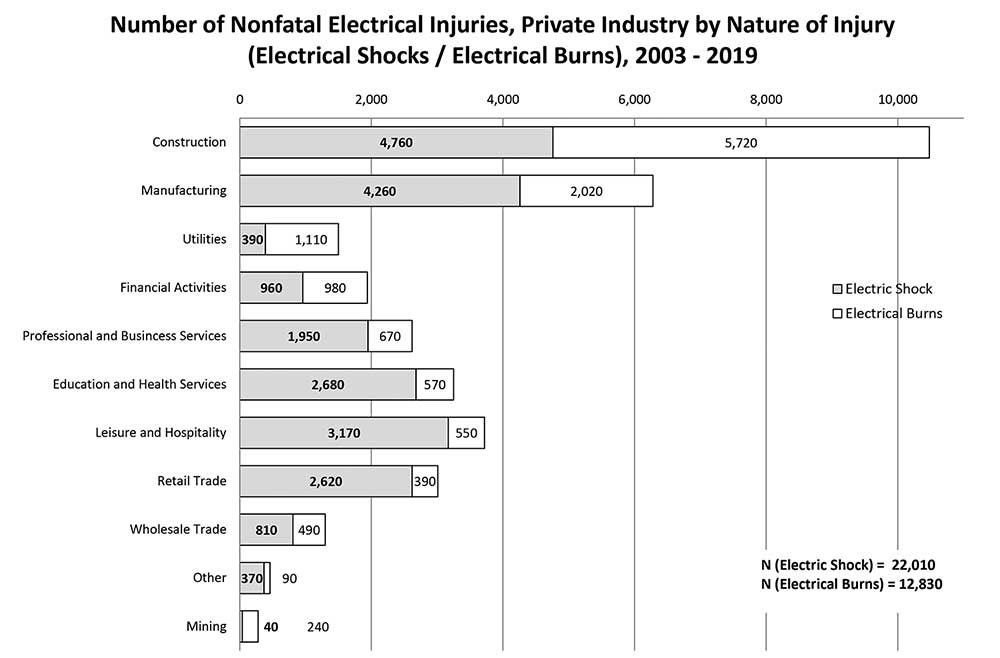
Service-producing industries accounted for the leading worker activity with 57% of all electrical injuries, while 43% occurred in goods-producing industries. The day of the week which incurred the highest percentage of nonfatal electrical injuries was Tuesdays with 32% of the total, followed by Wednesdays at 22%, Thursdays at 15%, Mondays and Fridays both at 12%, Saturdays at 6%, and Sundays at 2%. The number of hours worked with the highest percentage of nonfatal injuries was 6 to 8 hours, at 20% of all injuries. The next highest hour range was 4 to 6 hours at 19%, followed by 8 to 10 hours at 12%, 2 to 4 hours at 9%, 1 to 2, and 10 to 12 hours, both at 6%, 12 to 16 hours at 1%, and 27% were not reported.

The median number of days away from work for nonfatal electrical injuries was 9 in 2019, a 125% increase over 2018. The median days away from work caused by indirect or direct exposure to electricity also varied. The median days away from work for indirect exposure greater than 220 volts was three days, indirect exposure 220 volts or less was 17 days, direct exposure greater than 220 volts was 29 days, and direct exposure 220 volts or less was four days.
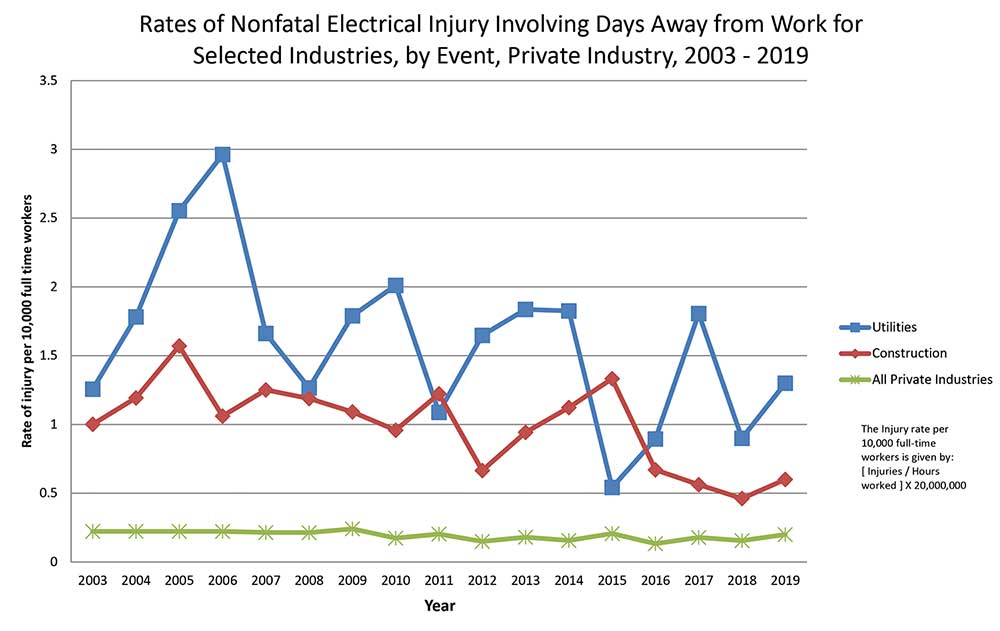
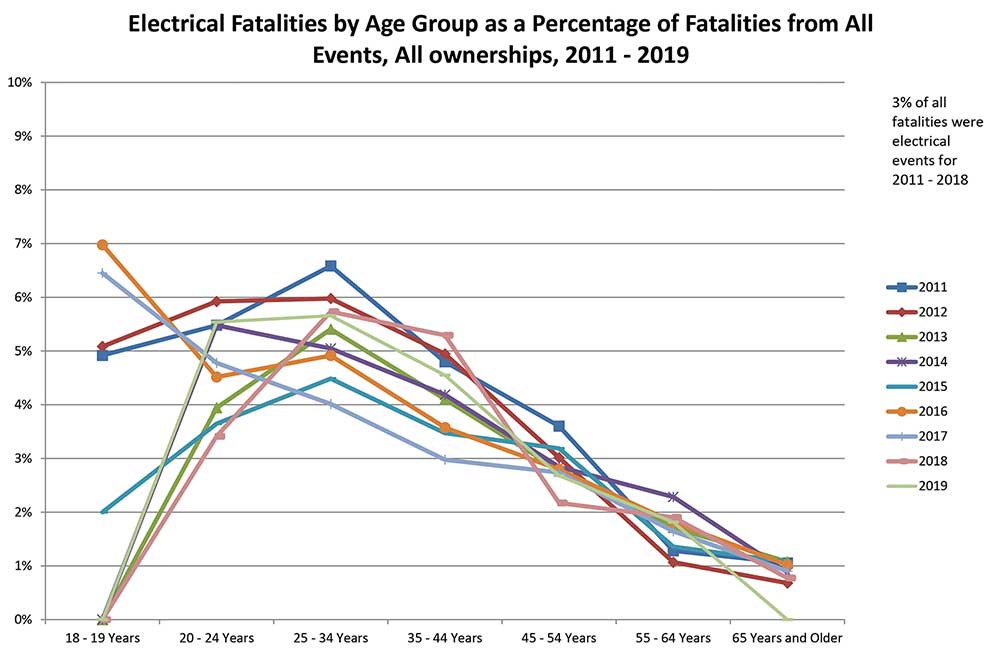
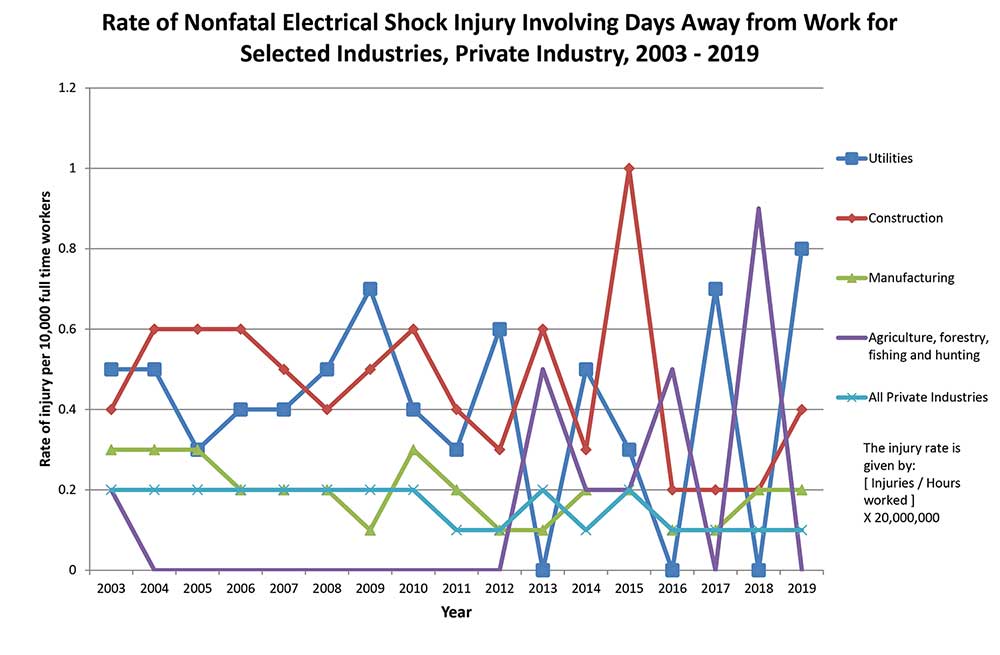
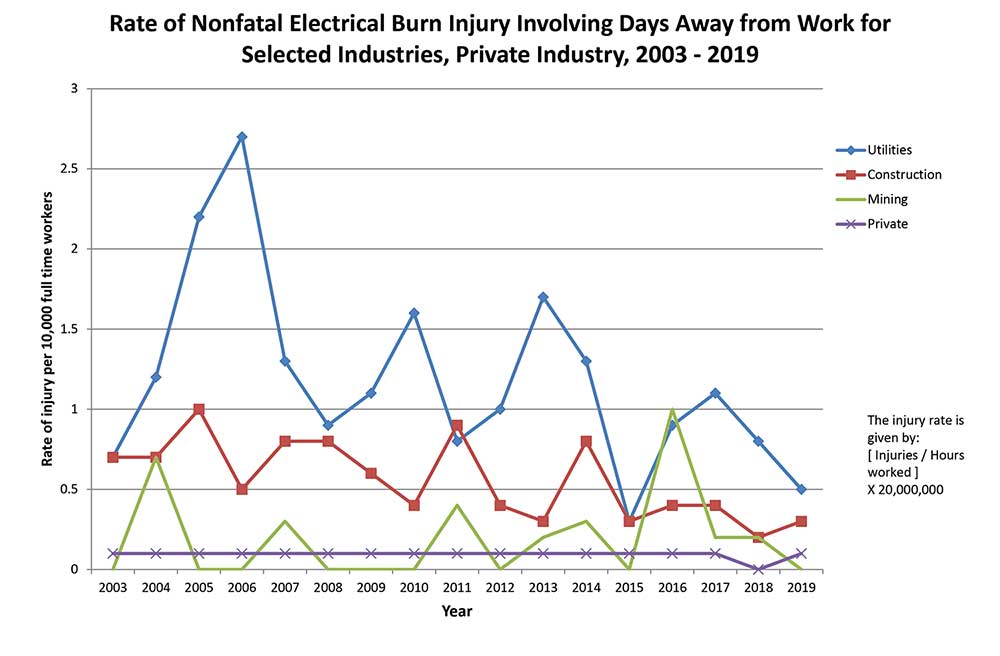
The most valuable asset to any workplace is the staff completing the work. Ensuring all workers make it home safely at the end of their shift should be the ultimate goal of any supervisor or manager. 2019 brought about the highest number of electrical fatalities since 2011. This shows that a greater focus needs to be placed on worker and workplace safety.
ESFI’s free to share resources were designed to bring awareness to the activities causing injuries and fatalities on the job site, such as the resources we created on avoiding overhead power line contact. Integrating these materials into a workplace safety training program can empower supervisors and workers alike to avoid these preventable incidents. While qualified workers are often willing to go above and beyond the call, some jobs require specific knowledge and experience. That’s why it’s important to know when to say when and know when to stop work. This simple action can save your life and the lives of those around you. For more information on workplace safety and to share these materials with your peers or coworkers, visit esfi.org.

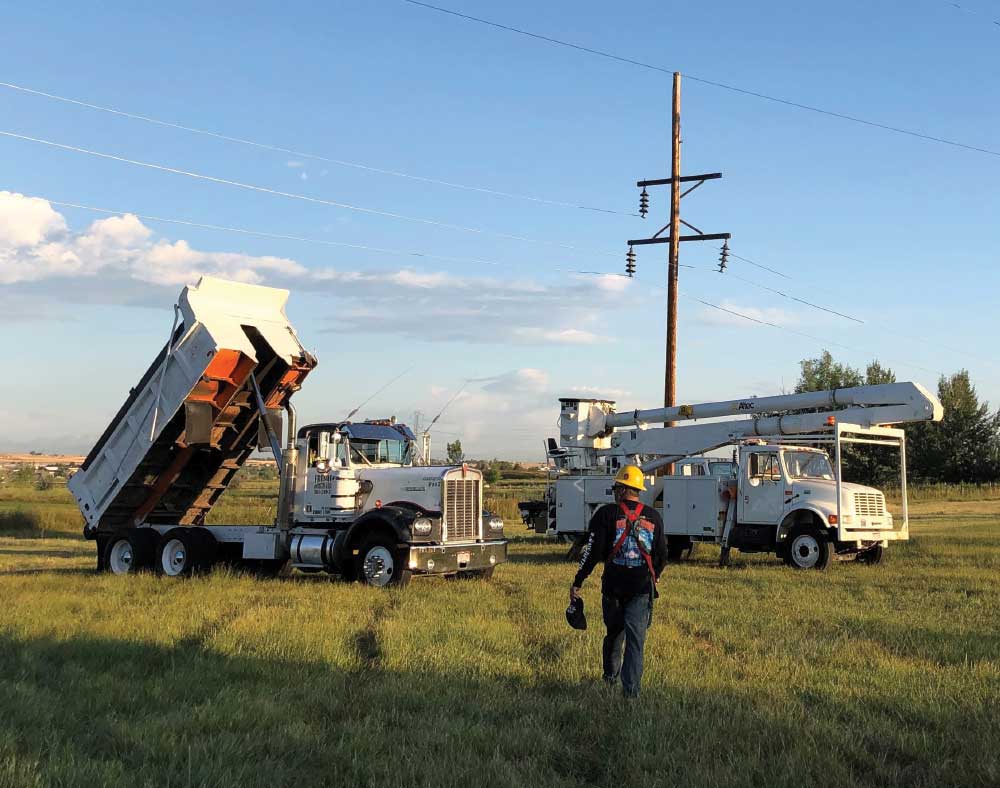








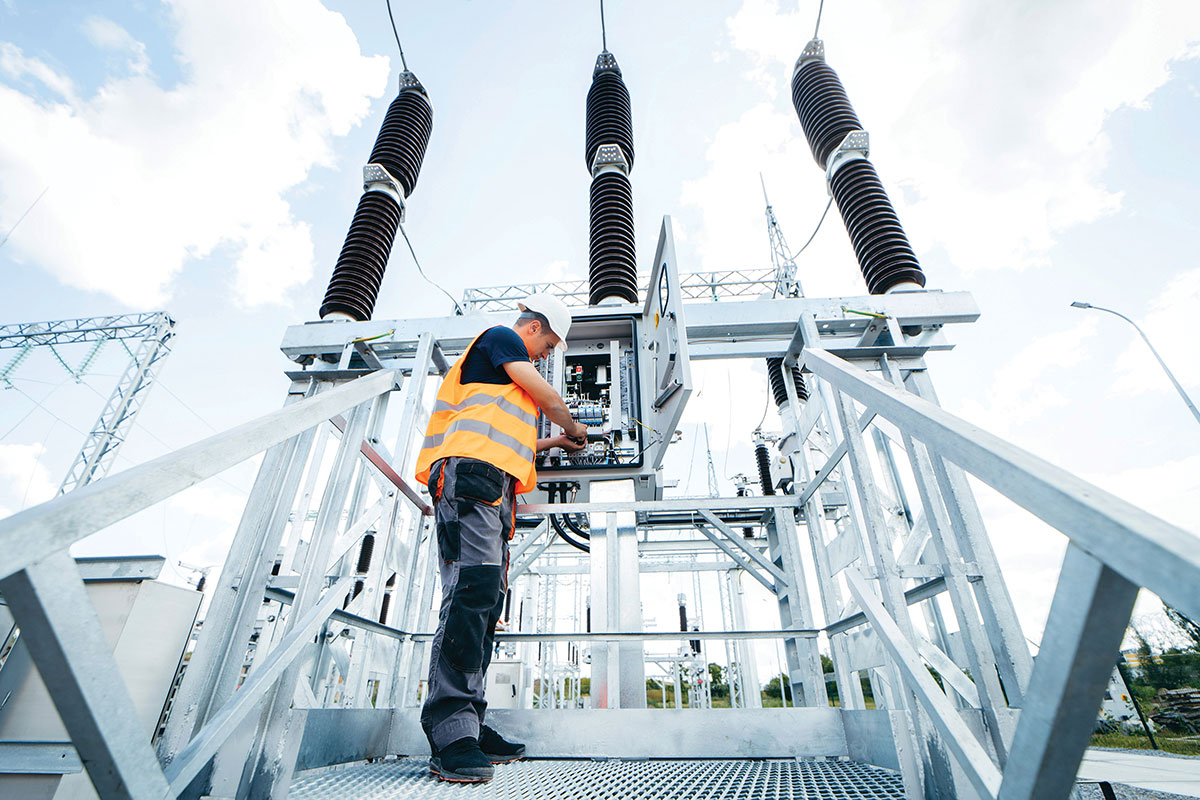
Find Us on Socials